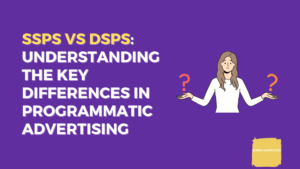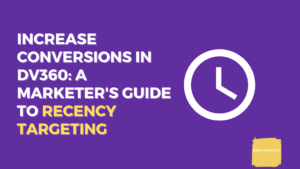What are the Types of YouTube Campaigns and How to Use Them Effectively
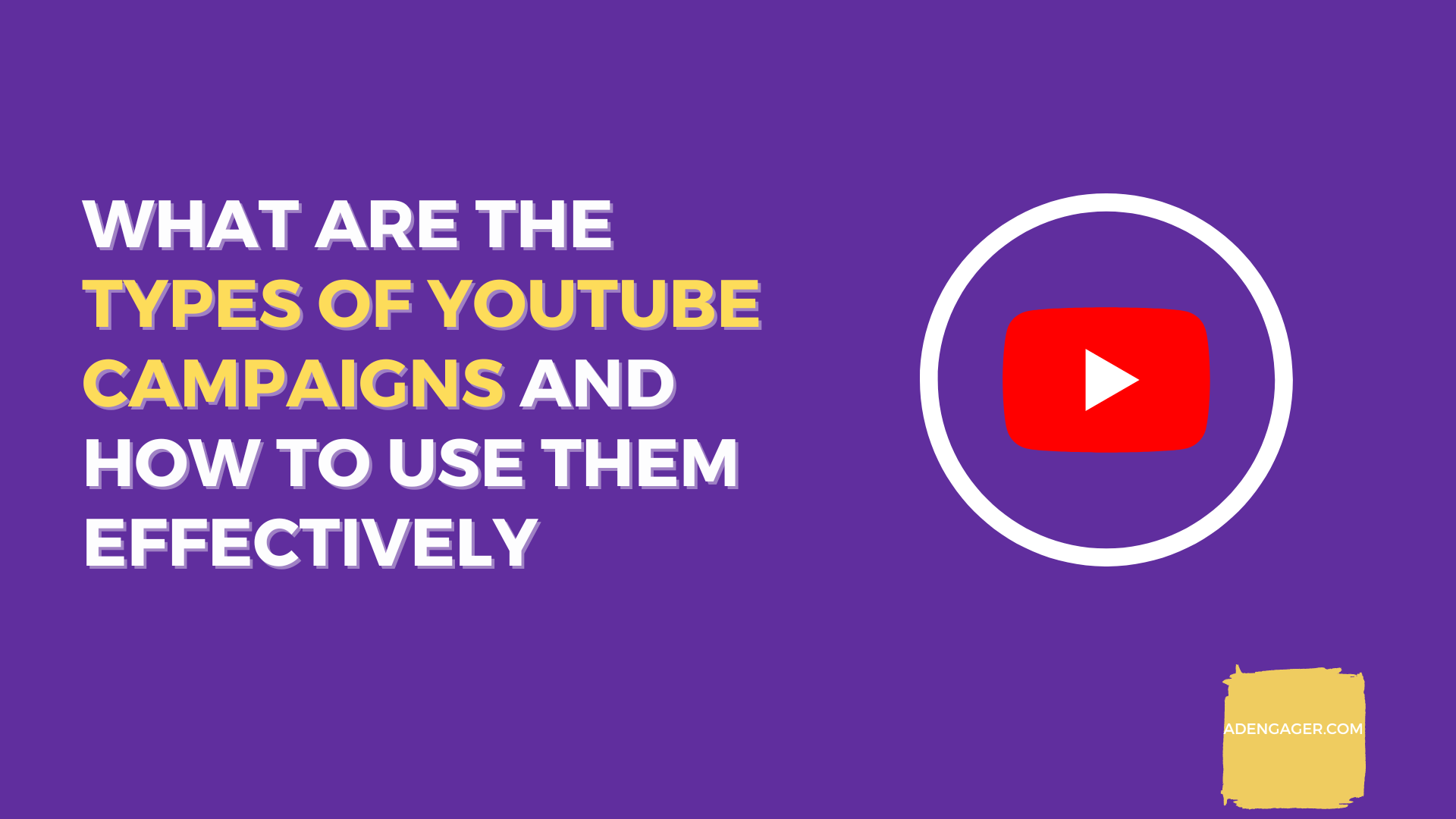
In the fast-paced and ever-evolving world of digital advertising, programmatic advertising has emerged as a game-changer, revolutionizing how brands connect with their target audiences. One platform that has witnessed significant transformations through programmatic advertising is YouTube, the world’s second-largest search engine and a leading video-sharing platform. With the advent of programmatic capabilities on YouTube, advertisers now have a powerful tool: YouTube campaigns on DV360. These campaigns offer various options to target, engage, and convert potential customers effectively. In this blog, we will delve into the different types of YouTube campaigns that can be run on DV360, exploring the ad formats, benefits, use cases, and best practices to help businesses optimize their advertising efforts on this dynamic platform. So, let’s dive into the world of programmatic advertising on YouTube and discover the possibilities to elevate your brand awareness, consideration, and conversions!
Definition of YouTube Campaigns on DV360
YouTube campaigns on DV360 are online advertising campaigns that allow businesses to reach their target audience on YouTube and other video-sharing websites. These campaigns can achieve various goals, such as increasing brand awareness, generating leads, or driving sales.
DV360 is a Google marketing platform that provides businesses with a single place to manage their online advertising campaigns across multiple channels, including YouTube. This platform allows businesses to target their ads more precisely, measure their results more accurately, and optimize their campaigns for better performance.
Importance of YouTube Campaigns for Businesses
YouTube is the second most popular website in the world, with over 2 billion active users. It means a huge potential audience for businesses to reach on YouTube. In addition, YouTube is a great platform for businesses to connect with their target audience on a personal level.
YouTube campaigns can be an effective way for businesses to achieve various marketing goals. For example,
YouTube campaigns can be used to:
- Increase Brand Awareness: YouTube campaigns can help businesses raise brand awareness among a wider audience. With the ability to showcase creative and engaging video content, brands can make a memorable impact and create a lasting impression on viewers.
- Generate Leads: YouTube campaigns can help businesses generate leads by giving viewers a call to action, such as a link to a landing page or a phone number. Businesses can capture potential customers and build their email lists by directing interested viewers to relevant conversion-focused pages.
- Drive Sales: YouTube campaigns can drive sales by promoting products or services to viewers. With various ad formats like skippable in-stream ads or responsive in-stream ads, businesses can entice viewers to make a purchase or take advantage of limited-time offers.
Types of YouTube Campaigns on DV360
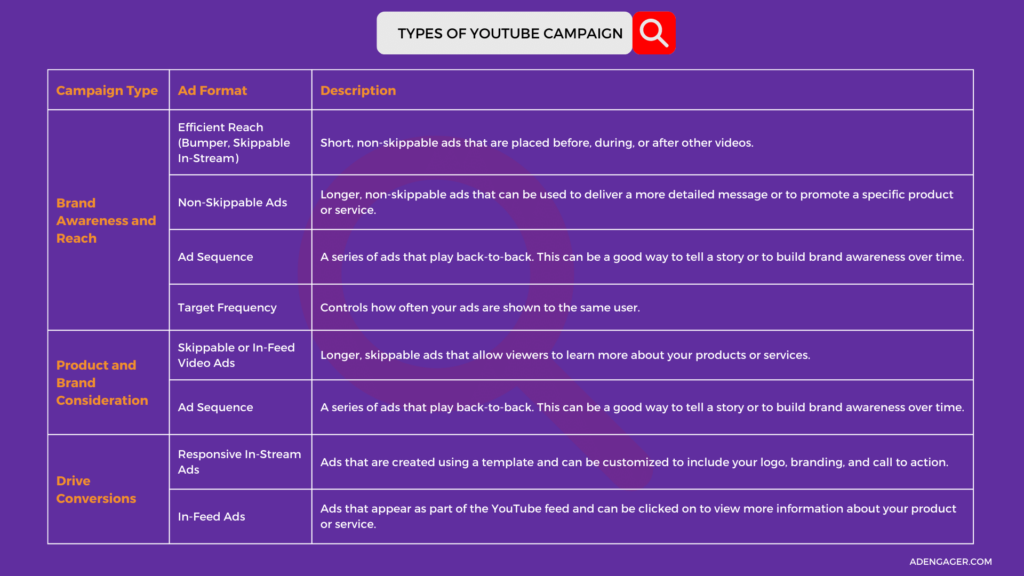
Three main types of YouTube campaigns can be run on DV360:
A. Brand Awareness and Reach
Brand awareness and reach campaigns are designed to increase brand awareness and reach a broad audience. They typically use short, non-skippable ads placed before, during, or after other videos.
| Ad Format | Description |
| Efficient Reach (Bumper, Skippable In-Stream) | These ads are 6 seconds or shorter and cannot be skipped. They are a good option for reaching a large audience with a simple message. |
| Non-Skippable Ads | These ads are 15 seconds or longer and cannot be skipped. They are a good option for delivering a more detailed message or for promoting a specific product or service. |
| Ad Sequence | This feature allows you to create a series of ads that play back-to-back. This can be a good way to tell a story or to build brand awareness over time. |
| Target Frequency | This feature allows you to control how often your ads are shown to the same user. This can help you to avoid annoying viewers and to ensure that your ads are seen by as many people as possible. |
B. Product and Brand Consideration:
Product and brand consideration campaigns are designed to generate interest in your products or services. They typically use longer, skippable ads that allow viewers to learn more about your offering.
| Ad Format | Description |
| Skippable or In-Feed Video Ads | These ads are 15 seconds or longer and can be skipped after 5 seconds. They provide more information about your products or services. |
| Ad Sequence | This feature can also be used with product and brand consideration campaigns. It can be a good way to tell a story or to build brand awareness over time. |
C. Drive Conversions
Drive conversions campaigns are designed to generate leads or sales. They typically use responsive in-stream ads that allow viewers to take action directly from the ad.
| Ad Format | Description |
| Responsive In-Stream Ads | These ads are created using a template and can be customized to include your logo, branding, and call to action. They are a good option for generating leads or sales because they allow viewers to take action directly from the ad. |
| In-Feed Ads | These ads appear as part of the YouTube feed and can be clicked on to view more information about your product or service. They are a good option for reaching users who are already interested in your products or services. |
Brand Awareness and Reach
Brand awareness and reach campaigns on DV360 are essential for businesses aiming to create a lasting impact on a broad audience. Let’s explore the different ad formats under this category:
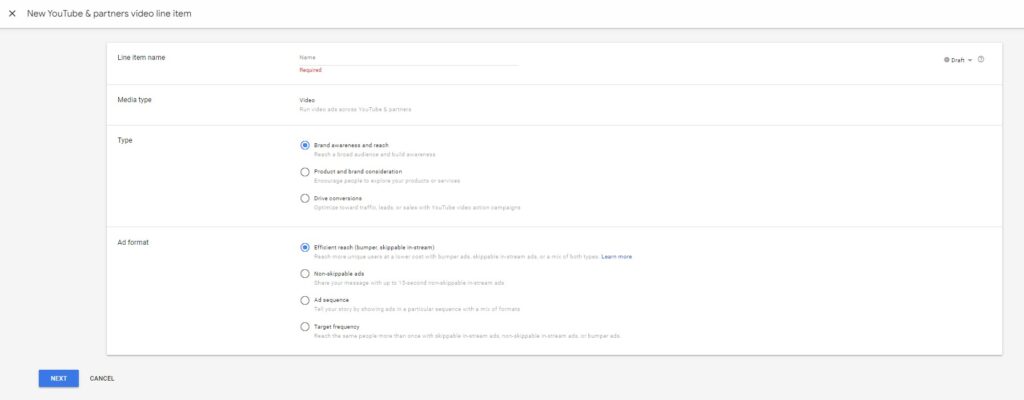
A. Efficient Reach (Bumper, Skippable In-Stream)
Definition and Purpose:
Efficient Reach ads are short, non-skippable ads lasting six seconds or less. Their primary purpose is to quickly and effectively deliver a concise message to a large audience.
Benefits and Use Cases:
Efficient Reach ads offer several benefits. They are cost-effective and can help businesses with limited budgets to maximize their reach. These ads work well when a brand wants to create immediate brand awareness or promote a specific product or service within a short time frame.
Best Practices for Implementing Efficient Reach Ads:
In Efficient Reach ads on youtube, businesses should focus on crafting a clear and impactful message that resonates with their target audience. Utilizing high-quality visuals and engaging audio can capture viewers’ attention within the short ad duration.
B. Non-Skippable Ads
Definition and Purpose:
Non-skippable ads are ads that viewers cannot skip. They are usually longer than Efficient Reach ads and can be used to deliver a more detailed message or promote specific products or services.
Benefits and Use Cases:
Non-skippable ads are ideal for businesses looking to convey a more in-depth message or showcase their offerings to the viewers. These ads are suitable for reaching a specific audience with precision.
Best Practices for Implementing Non-Skippable Ads:
When creating Non-Skippable ads, businesses should focus on crafting engaging and informative content. A compelling call to action should also be incorporated to encourage viewers to take the desired action, such as visiting the website or signing up for newsletters.
C. Ad Sequence
Definition and Purpose:
Ad sequences involve a series of ads that play back-to-back. This format enables businesses to tell compelling stories or build brand awareness over time.
Benefits and Use Cases:
Ad sequences provide the opportunity to present a cohesive narrative, allowing businesses to keep viewers engaged and interested. They are particularly effective for campaigns that build brand affinity and loyalty.
Best Practices for Implementing Ad Sequences:
For successful ad sequences campaigns, businesses should ensure that the group of ads is coherent and interconnected, forming a unified storyline. Including a call to action in each ad can encourage viewers to take the desired action at different points in the sequence.
D. Target Frequency
Definition and Purpose:
Target frequency is a setting that controls how often an ad is shown to the same user. It helps businesses manage ad frequency to avoid overexposure to viewers.
Benefits and Use Cases:
Target frequency benefits businesses looking to optimize their ad reach while avoiding viewer fatigue. By finding the right balance, businesses can ensure that a diverse audience sees their ads without becoming repetitive.
Best Practices for Setting Target Frequency:
Setting target frequency requires careful consideration of budget and campaign objectives. Testing different frequency settings allows businesses to determine the optimal balance between reaching a wider audience and avoiding ad fatigue for individual viewers.
Product and Brand Consideration
Product and brand consideration campaigns on DV360 play a crucial role in generating interest in your products or services. These campaigns utilize longer, skippable ads, enabling viewers to learn more about your offerings.

A. Skippable or In-Feed Video Ads
Definition and Purpose: Skippable or in-feed video ads are ad formats that allow viewers to skip the ad after 5 seconds. The purpose of these ads is to provide more in-depth information about your products or services.
Benefits and Use Cases: Skippable or in-feed video ads are ideal for businesses seeking to engage their audience with detailed content. They provide an opportunity to showcase product features, demonstrate service benefits, or convey brand values effectively. This ad format is particularly valuable for brands targeting specific target demographics.
Best Practices for Implementing Skippable or In-Feed Video Ads: It is essential to design captivating and informative content to create effective skippable or in-feed video ads. Businesses should craft compelling visuals, captivating storytelling, and a clear call to action to prompt viewers to take the desired action, such as visiting a website or subscribing to a newsletter.
B. Ad Sequence
Definition and Purpose: Ad sequences refer to ads that are played consecutively. This format is ideal for businesses aiming to tell a compelling story or gradually build brand awareness over time.
Benefits and Use Cases: Ad sequences provide businesses with a powerful storytelling tool, allowing them to create a cohesive narrative that resonates with the audience. This format benefits campaigns focused on brand storytelling, product launches, or seasonal promotions.
Best Practices for Implementing Ad Sequences: When implementing ad sequences, businesses should ensure that each ad complements the previous one, creating a seamless and engaging experience for viewers. The story arc should be well-structured, and a strong call to action should be included in each ad to encourage viewers to take the desired action.
Drive Conversions
Drive conversions campaigns on DV360 are strategically designed to generate business leads or sales. These campaigns employ two main types of ads: responsive in-stream ads and in-feed ads, which enable viewers to take action directly from the ad.

A. Responsive In-Stream Ads
Definition and Purpose:
Responsive in-stream ads are a highly customizable ad format that includes your logo, branding, and a compelling call to action. These ads are strategically designed to drive conversions by allowing viewers to take immediate action directly from the ad itself.
Benefits and Use Cases:
Responsive in-stream ads offer businesses a powerful tool to drive conversions effectively. By providing a seamless user experience, viewers can quickly engage with the ad and take the desired action, such as signing up for a newsletter or purchasing. These ads are particularly valuable for businesses aiming to increase lead generation and boost sales.
Best Practices for Implementing Responsive In-Stream Ads:
For responsive in-stream ads, businesses should ensure the ad content is clear, concise, and relevant to the target audience. A strong and compelling call to action should be prominently displayed, guiding viewers toward the desired conversion. Additionally, thorough testing and optimization of ad creatives can help determine the most effective approach for achieving conversion goals.
B. In-Feed Ads
Definition and Purpose:
In-feed ads are seamlessly integrated into the YouTube feed, making them appear as part of the user’s content consumption experience. They are designed to drive conversions by providing viewers with a direct call to action within the ad.
Benefits and Use Cases:
In-feed ads allow businesses to reach viewers who are already interested in their products or services. By blending in with the natural content flow, these ads can capture the attention of potential customers and encourage them to take immediate action, such as downloading an app or exploring a new product.
Best Practices for Implementing In-Feed Ads:
When implementing in-feed ads, businesses should ensure the ad content aligns with the surrounding video content, ensuring relevance and engagement. A clear and actionable call to action should be strategically placed within the ad to encourage viewers to take action. Regular monitoring and optimizing performance metrics can help refine the ad approach and maximize conversion potential.
In conclusion, YouTube campaigns on DV360 offer businesses a versatile and powerful way to reach their target audience, increase brand awareness, drive consideration, and boost conversions. By utilizing various ad formats and best practices, businesses can engage viewers effectively, maximize campaign performance, and achieve their marketing objectives precisely in the dynamic digital landscape. Embracing YouTube campaigns on DV360 is key to staying competitive and fostering growth in the ever-evolving world of online advertising.

